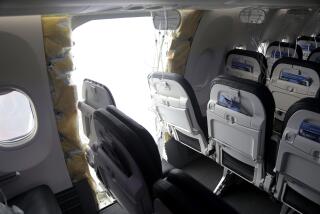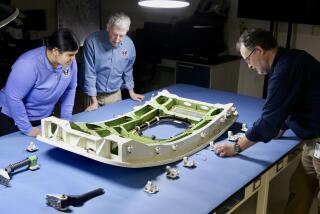Ground All DC-10s, Passenger Group Suggests
- Share via
Citing “inherent design flaws,” the International Airline Passengers Assn. suggested Thursday that the DC-10 airliner may have to be grounded “to protect and safeguard the lives of those exposed to the perils” of flying on the jumbo jet.
Officials at the Long Beach headquarters of McDonnell Douglas, manufacturer of the jetliner, responded that the plane is a reliable, well-designed aircraft and called the demands of the 11,000-member airline passengers’ group “ridiculous.” The plane has long been certified as safe by the Federal Aviation Administration.
The association’s petition to the FAA--and McDonnell Douglas’ response--came a few hours after a Korean Air DC-10 crashed while attempting to land in Tripoli, Libya, killing at least 71 of the 199 on board. Unconfirmed accounts indicated that the pilot had reported engine trouble before the crash.
Iowa Crash Recalled
Just eight days earlier, a United Airlines DC-10 crashed while attempting an emergency landing in Sioux City, Iowa, killing 111 of the 276 aboard. Preliminary reports indicate that one of the plane’s three engines exploded during that flight, knocking out the jetliner’s hydraulic control systems.
Aviation sources were quick to point out that McDonnell Douglas does not build the engines used in its planes--the engines in various models are manufactured by General Electric and Pratt & Whitney.
In his letter to FAA Administrator James P. Busey, association chairman James E. Dunne urged that the FAA take “immediate and aggressive action” to see that any design flaws in the DC-10 are corrected.
Citing the crash at Sioux City, in which fragments from the exploding engine caused the plane’s three, redundant hydraulic systems to fail simultaneously, Dunne recalled an earlier IAPA recommendation to the FAA, which read, in part:
“The various parallel hydraulic and electrical systems of the DC-10 should be sufficiently separated from each other by structure or distance, so that in the event of accidental damage to one system, it would be unlikely that the other backup systems could be affected by the same source of damage.”
Manufacturer Responds
Dale Warren, a McDonnell Douglas vice president, responded Thursday afternoon that the problems at Sioux City did not result from a lack of system separation.
Warren said the three systems were cut in three different places--separated by at least five feet--in the tail section of the plane when shrapnel from the exploding engine flew in all directions in what federal investigators have said was an extremely unusual disintegration of virtually the entire engine shaft assembly.
Investigators say the loss of hydraulic fluid from all three systems meant the pilots could no longer use the plane’s normal control surfaces--rudder, ailerons, horizontal stabilizers, flaps, slats and spoilers--and had to rely solely on the two remaining engines to control the plane.
Warren said McDonnell Douglas has ordered no changes as a result of the Sioux City crash, but he said the company is studying possible ways to better protect the hydraulic systems.
Warren noted that DC-10s have carried more than 745 million passengers more than 7 billion miles since they went into service in July, 1971.
“McDonnell Douglas believes the overall safety record of the DC-10 is worthy of public confidence,” Warren said.
More to Read
Inside the business of entertainment
The Wide Shot brings you news, analysis and insights on everything from streaming wars to production — and what it all means for the future.
You may occasionally receive promotional content from the Los Angeles Times.










